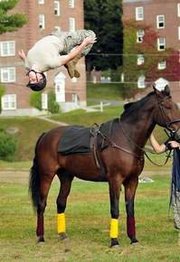Sometimes the good die old. I have always dreaded the day that I would walk by Homer’s stall and he would be gone. It is impossible to run away from the fact that he will no longer be the #1 Breckenridge Farm Ambassador. There is no more hiding behind his cute smile. The first thing that I must do as I step up to the “face” is say, “thank you!”
Life is all about counting blessings. I have been showered with the best of family, friends and animals. So many blessings to count, and if I need to keep tally, then Noble’s Trim (Homer) holds several counts! His heart and mind gave miles beyond his physique. No matter what I asked of him, from carrying a frightened child to leading the N.U. Cavalry Troop in an Alumni Parade, he gave all he could, and more.
Thank you, Homer, for making my job so much easier! It was always amazing to watch you begin a movement that I was teaching someone before they even gave you the aids.
I thank you for:
- Your sense of humor — pushing us over with your nose when we were least expecting it, biting your son Barney’s butt when he didn’t move fast enough in the drill team pinwheel, following the lessons when you were let out to free graze and loading yourself onto students trailers
- Being the fearless leader — like a metronome in drill team, like a true soldier on campus, and a gentle friend in kid’s camp~
- Winning all those Blues — for me, for students, and for our Lindsay (she will never forget the “clean sweep” at the 3 day 4-H show!)~
- Helping introduce our son Josh to our now daughter-in-law Chery when she rode you so beautifully in Event Camp.
- Sharing the trails with me on our solitary exploration rides~
- The recognition you brought the farm — by being featured in Jane Savoie’s Cross training book, on the cover of Linda Tellington Jones’ newsletter, in ads for feed stores and local businesses, in dressage articles and in Norwich University photos. You had such wonderful performance presence!
This tribute is a thank you, not a good-bye. Homer was wise and honest. He wore his heart on his sleeve — never a question about his opinion of something.
Before he left, I tried to memorize his markings. His “spots” were special; he actually had a chestnut-colored heart on his right hip leading to that handsome Appy blanket. I know I won’t always remember exactly how he looked, but his heart marking will forever remind me to live passionately and honestly.
Today, I will plant wildflowers under the apple tree where my friend is buried.
It won’t surprise me if they bloom on demand.


